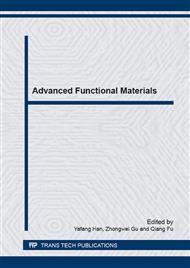p.385
p.390
p.396
p.401
p.407
p.412
p.424
p.429
p.434
Excellent Cell Compatibility in Time Controlled Silk Fibroin Hydrogels
Abstract:
Various methods were developed to prepare hydrogels including photo-cross-linking, chemical cross-linking, enzymatic cross-linking, pH or temperature-induced gelation, ionic interaction, and hydrophobic interactions. Whereas silk fibroin gelation time was difficult to control by physical methods, the cross-linkers used in chemical technique were likely to reduce the cell biocompatibility. Sodium N-Lauroyl Sarcosinate (SNS), an amino acid-based surfactant, came into accelerate silk fibroin to form silk hydrogel. To monitor the gelation process and determine the gelation time, turbidity changes during gelation were measured by Synergy HT. Cylindrical gels have been measured with universal material experiment machine and KES for mechanical properties. Fibroblast (L929) cells were seeded on the surface of hydrogels to investigate the cell compatibility. The results show that the SNS/SF gelation time ranges from 20 min to 120 min, which is affected by environment temperature, the final concentrations of SF and SNS. Compared with pure silk fibroin hydrogels, the compression strength of SNS/SF gel is much stronger. SNS/SF gel has excellent compression-recovery performance in KES test as well. A logarithmic stable cell growth appears on the surface of SNS/SF hydrogels, which indicates that SNS/SF hydrogels have excellent cell compatibility. Therefore, the SNS/SF hydrogels have great potential in tissue repair for surgery.
Info:
Periodical:
Pages:
407-411
Citation:
Online since:
March 2015
Authors:
Keywords:
Price:
Сopyright:
© 2015 Trans Tech Publications Ltd. All Rights Reserved
Share:
Citation:


